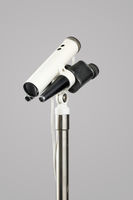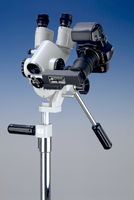Company's History
The Origins
The origins of Leisegang go back to the end of the 19th century. In 1889, Georg Leisegang Senior founded what was originally a drug store. Soon afterwards, this was converted into a photographic retail store chain. Business flourished until World War 2 completely destroyed Berlin. Leisegang was bombed out during airstrikes.
After the the war, reconstruction began and Leisegang was re-established by Fritz Leisegang. A repair shop for cameras was established as a sideline.This later developed into a specialized manufacturing business for photographic products.
In 1948, Professor Bracht, the then chief gynaecologist of Berlin hospitals, turned up at Fritz Leisegang door, the managing director of Leisgang Photography and inquired whether the "Leisegangs" could build him a colposcope. After a short explanation of the medical requirements, recognizing that it was quite a fitting product for his small precision-mechanics and optical business which was associated with his photo company, Mr. Leisegang accepted.
Soon after this, a single colposcope was built. After this first model, more devices were made, until every examination chair in the clinic had been fitted with a colposcope.
The First Colposcopes
These first devices were built with the help of the optical business's existing prism glasses. Fritz Leisegang along with his two sons Peter, a precision engineer, and Georg, a qualified optician, looked for ways to improve the colposcope both mechanically and optically.
In 1950 Leisegang achieved a further innovation: the first mono photo colposcope. With this innovation, the ability to take pictures and to document the examination results became a reality.
Documentation with Patient Data
This was followed in 1958 with the launch of the stereo photo colposcope. With this model the photo was taken as a split image and was viewed by a so called stereo viewer. Due to it's split nature, the picture appeared three-dimensional, thus giving it the vivid impression of a direct view. This model was applied mainly in the fields of teaching and research.
In the same year Leisegang's printing device arrived on the market, making possible direct transmission of patient data in the picture, or rather the slide. Confusion could thus be avoided and clear patient data and examination photos given.
The Balance-o-Matic stand conquers the market
At around the same time, stands were also further developed. In the mid-60s the balance-o-matic stand developed from the swing-o-matic stand. Due to a balanced, effortless movement system, vertical movement was"weightless" and therefore very convenient to use. Even today, it is still Leisegang's best selling stand.
At the end of the sixties, colposcopy was increasingly adopted in the US and its use grew throughout the world. This was a development that was also considerably noticable in Germany: while Peter Leisegang led production in the Berlin firm, Fritz Leisegang visited trade shows and conferences to present the colposcopes. Georg on the other hand presented their colposcopes in specialised clinics around Germany. He pragmatically toured the country in an especially adapted VW bus, complete with colposcope and stand, visiting gynaecologists, hospitals and specialist dealers, demonstrating the uses of the device on site.
"Stereo Instant Photo Colposcope" and Digital Image Display
In 1977, the first colposcope with a magnification changer for 3 magnification steps (x 7.5/15/30) was launched. A so-called s-magnification (x 3.75/7.5/15) was developed for the American market in 1991, and focusing particularly on the area of child abuse. In Germany, too, the s-magnification prevailed.
In the same year the stereo instant photo colposcope was launched. The attached Polaroid camera made it possible to create a photo immediately without developing the film.
In the 1970s, the Leisegangs were colposcope market leaders in Germany. From there, they expanded the company worldwide. Fritz Leisegang died in 1981 at the age of 81 and after this, George Leisegang took over commercial leadership of the company.
In 1985 Leisegang developed a video adapter, initially with a single magnification step (x 15), and later with 3 magnification steps (x 7.5/15/30). This allowed a retrofitting of standard colposcopes and for the first time it was possible to transfer a digital image to a monitor.
Developments in the area of illumination also took a significant step forward: in 1984 Leisegang presents their first model which operated with fiber optics and an external light source. Unhelpful heat development, a normal consequence of bulb light, was considerably reduced, while illumination was at the same time improved.
In 1985 the company's global expansion in both sales and distribution led to the founding of its own sales company "Leisegang Medical Inc." in the United States. With this, Leisegang developed a market share of nearly 75% to become the market leader in the US. In 1994, Lutz Leisegang, a nephew of Fritz, joined the company. His excellent language skills led to an immense increase in exports.
Leisegang became part of the the leading US medical technology company Cooper Surgical Inc., USA, to whom it still belongs today.
First LED Lighting Worldwide
Meanwhile, product development continued, and in 2005 a colposcope with intregrated digital camera was launched, its slim design facilitating a greater ease of handling.
In 2008 Leisegang became the first company in the world to launch a white-light LED lit colposcope. Being continuously adjustable, and with a significantly higher light intensity, led to a considerably improved contrast.
Market Development in China
Another significant step forward, Leisegang began market development in China and in less than 4 years, became the market leader in the high end sector.
Today, Leisegang is the market leader in Germany, roughly every second colposcope in use is from Leisegang). In the high end sector, Leisegang is the market leader in the US, Russia and China, as well as in a number of European and Asian countries.
Meanwhile, Leisegang colposcopes are used in more than 80 countries, on every continent, and are recognised as the gold standard of colposcopes.
















